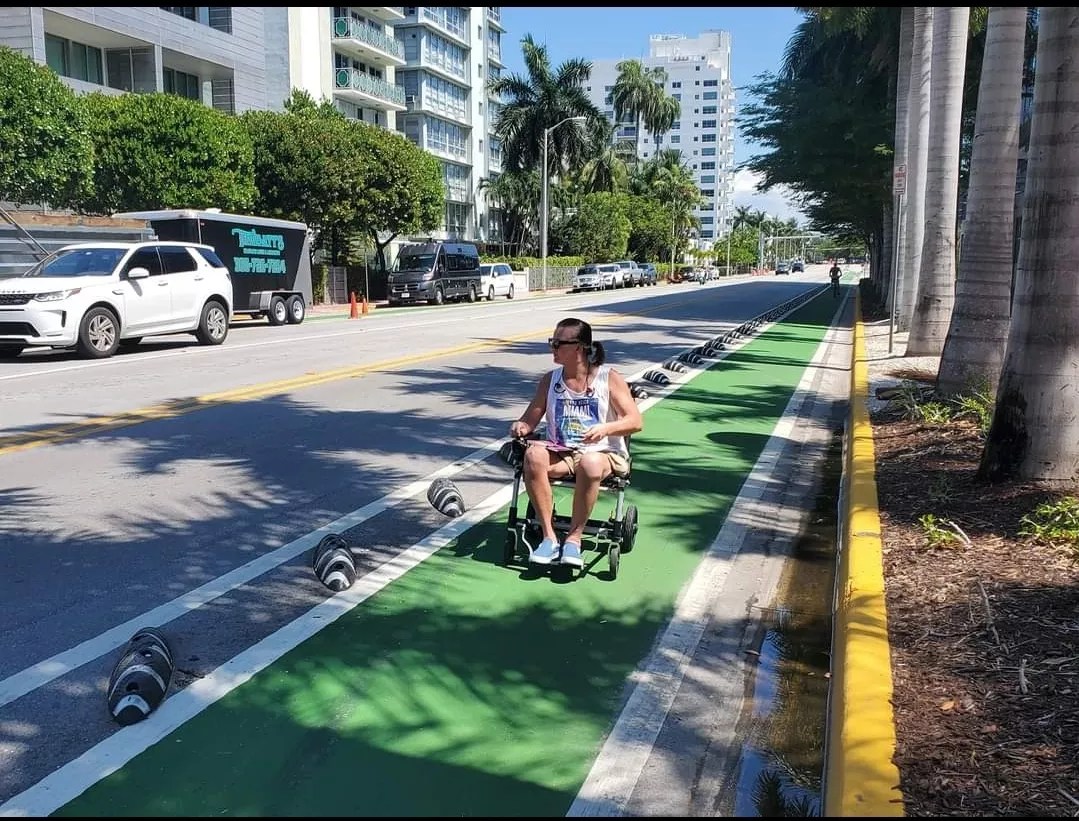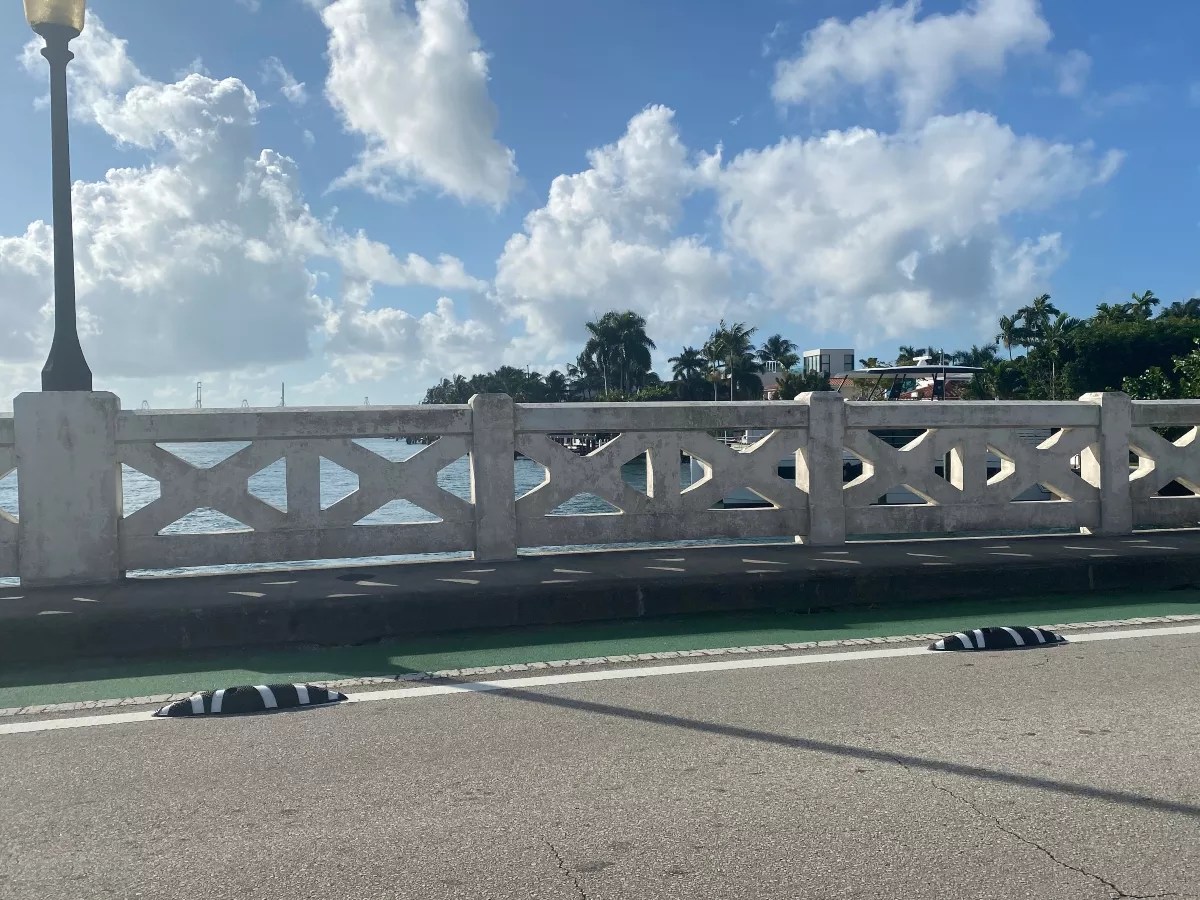
Photo courtesy of Anthony Penta

Audio By Carbonatix
At the end of last year, Miami-Dade County installed relatively small, striped plastic barriers – called armadillos for their vaguely similar shape – to keep cars from drifting into the bike lane on the Venetian Causeway.
Though they’re intended to keep pedestrians safe, one Miami Beach resident says they had the opposite effect. An encounter with an armadillo on his electric scooter in February left Anthony Penalta with a broken leg that has required two surgeries to repair. As Miami-Dade County Mayor Danielle Levine Cava promised to improve safety measures on the Rickenbacker Causeway following the recent deaths of Yaudys Vera and Ogniana Reyes, Penalta wants to share the details about his mishap as a cautionary tale.
“These [armadillos] are sitting like, four or five inches off the ground,” Penalta, 60, tells New Times. “It’s almost like they want you to have an accident.”

Plastic barriers, called armadillos, were installed on the Venetian Causeway at the end of last year.
Photo by Michael Majchrowicz
This year, make your gift count –
Invest in local news that matters.
Our work is funded by readers like you who make voluntary gifts because they value our work and want to see it continue. Make a contribution today to help us reach our $30,000 goal!
Following the passage of HB 453 in 2019, electric scooters can be ridden in bike lanes and on sidewalks. Penalta, who uses an electric scooter as his primary mode of transportation, is a critic of the new armadillos. And he isn’t alone: Since their installation, these little plastic humps have divided the city’s cycling ranks, and a petition to remove them has already garnered more than 1,600 signatures.
“I did 13 years in the army and I didn’t injure myself,” Penalta says. “These [armadillos] are a nightmare.”
Miami is among the deadliest cities in the nation for cyclists: The Florida Department of Highway Safety and Motor Vehicles reported 795 bicycle crashes in Miami-Dade County in 2021. Of those, 730 resulted in injury and 17 resulted in fatalities.
Though proponents of the armadillos argue they’ll keep cars out of the bike lane and protect nonvehicular traffic from faster-moving vehicles, some cyclists seem to be more concerned with what happens should their front tire come into contact with one of the barriers when passing slower commuters, especially at higher speeds.
On top of that, Penalta says, the black-and-white striped armadillos are hard to see on the road at night. It was roughly 10 p.m. on February 22 when he bumped the armadillo on his scooter.
“It’s dark outside, and these things are black,” he explains. “There’s reflective tape, but there’s not really anything that’s reflected.”
When Penalta realized he was hurt too badly to walk, he called a Lyft to take him to the nearest Veterans Affairs hospital.
“Everything after that is like a dream,” he recounts. “Next thing I know, I’m looking at my leg, and it didn’t look good. My leg was not straight – like something was definitely wrong.”
As it turned out, Penalta had fractured his tibial plateau, the flat portion at the top of the tibia where it meets the femur. The following morning, he was moved to a different hospital, where he underwent surgery to immobilize the knee joint. Three days later, after the swelling went down, a second surgery was performed to install rods and plates in his leg.
Now, 12 screws and two plates hold the tp of his tibia bone in place. Nearly three months after the accident, he still can’t place weight on his injured leg.

An X-ray image of the screws and plates in Anthony Penta’s leg
Photo courtesy of Anthony Penta
Having had time to contemplate the circumstances surrounding his injury, he ventures that plastic poles like the ones used to separate the express lanes on I-95 would be a safer alternative to the armadillos.
“Those sticks in the HOV lane – at least they give,” he notes. “You hit one of those and they give. The base of it is so minimal, it’s not going to cause any kind of damage.”
Penalta hopes Miami-Dade County removes the armadillos before someone else is injured or possibly killed after hitting one, and that they’re not installed on the Rickenbacker Causeway as a so-called safety measure.
“Listen to the voices,” he says. “Those things are deadly.”